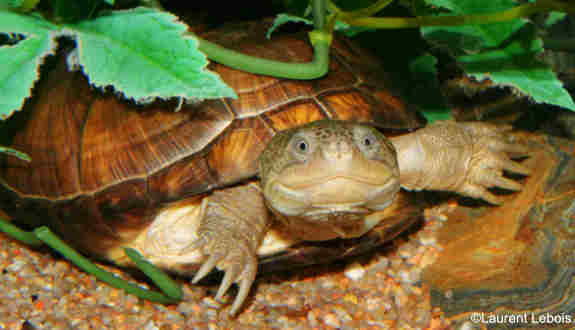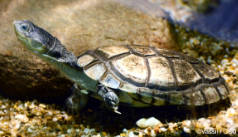

Alternative species (click on the thumbnail to see the card)
Names
Scientific name
Pelusios castaneus
Pelusios niger (mistake)
Pelusios subniger (mistake)
Common name
West African Mud Turtle
West African side-necked turtle
Swamp terrapin
Origin

Origin: West Africa (from Angola to Senegal)
Biotope: swamps, ponds, lakes and slow rivers
Dimorphism
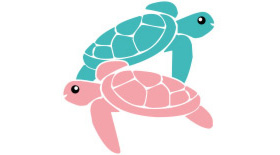
Sexual dimorphism can only be done with certainty with 10-12 cm (4-4.8") turtles. The tail of the male is more developed than in the female: it is longer and wider.
Group
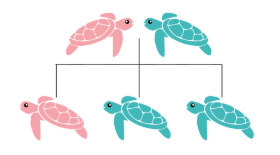
Pelomedusidae
Length

For 1: 120x40x50cm
or 47x16x20"
Temperatures
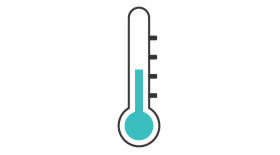
Beach day: 32 to 34°C or 89 to 93°F
Water: 26 to 28°C or 79 to 82°F
Difficulty

Easy
Size

up to 25cm (9.8")
Longevity

more than 15 years
Zone
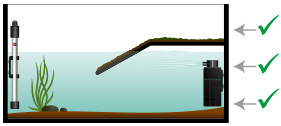
Earth (beach) and water
Individuals
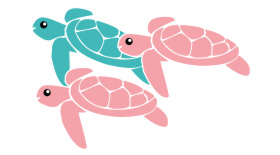
1
Food
How to feed the Pelusios castaneus?
Food
How to feed the Pelusios castaneus?
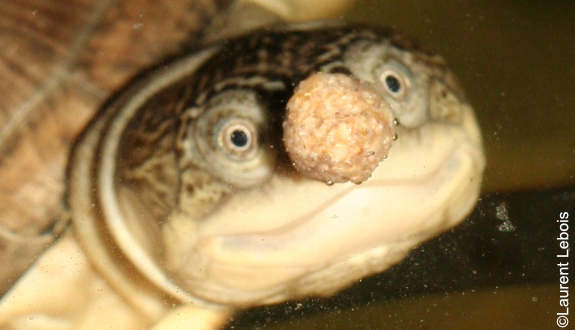
This species of aquatic turtle is omnivorous but mainly carnivorous. It is easy to feed. To ensure your pet's good health, vary your meals as much as possible. You have the choice with:
- - slugs and worms of all kinds (earthworms, mud worms, mealworms - occasionally maggots)
- - freshwater fish such as perch, bleak, roach or smelt (seawater fish and some freshwater fish should be avoided because they contain the antivitamin B1, which is harmful to the health of the turtle. It is the case of carps, sculpins, catfish, red fish, shrimps or marine mussels)
- - small snails with their shells (rich in calcium)
- - insects (crickets, cockroaches)
- - meat (chicken, turkey...)
- - chicken or beef liver, rich in vitamin A (occasionally)
- - fledglings, mice
- - lettuce and duckweed, water hyacinth
- - vegetables (spinach, watercress, endives, chard, clover, dandelion...)
- - fruits (banana, peach, apples, pears: small quantity and occasionally)
- - good quality granules (Zoo med, Exo Terra, Komodo...)
In addition, you can provide a cuttlefish bone in the aquarium. That will bring a natural complement of calcium.
Obviously, cooked, salted, dried or smoked foods are to be banned.
You can feed with small quantities (head size) up to 2 times a day depending on the age of the turtle. However, fasting once a week is beneficial.
Behavior
What kind of behavior does the Pelusios castaneus have?
Behavior
What kind of behavior does the Pelusios castaneus have?
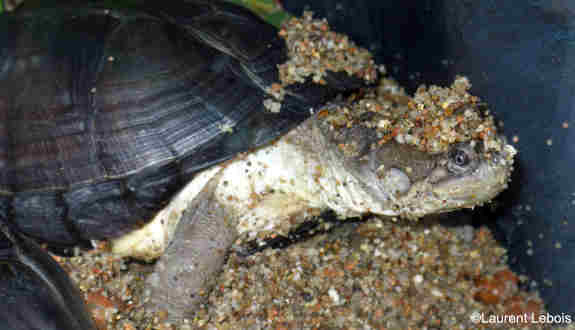
Thanks to its webbed hind legs, this turtle is an excellent swimmer. It is a shy and fearful species that needs hiding places to feel safe.
In the wild, many water holes dry up in the summer due to the heat. This is the time for this turtle to summer: it buries itself in the mud until the rain comes back. In aquariums, the observation of this period is not obligatory. It is sometimes even dangerous for farm animals that do not have such a wide variation in their environment. Nevertheless, aestivation is essential for the reproduction of this species. To simulate drought and allow your turtle to bury itself, put a thick layer of fine sand at the bottom of the aquarium or in a tray placed on the emerged part. Gradually lower the water level and gently raise its temperature to 29-31°C or 84-88°F. Normally, the turtle will reduce its activity and feeding: it will not be long before it buries itself for a few weeks (4 to 6 weeks in the wild).
Cohabitation
Who can live with the Pelusios castaneus?
Cohabitation
Who can live with the Pelusios castaneus?
This turtle lives very well alone. This is moreover our recommendation for most aquatic turtles which are very territorial and aggressive towards their congeners (this is particularly true for males).
However, note that cohabitation is more likely to work with females of the same size. A trio (1 male and 2 females) can also be considered (but not a pair). Unfortunately, even if all the conditions are met for a good cohabitation, it remains delicate and can degenerate from one day to the next. Keep in mind that at any time you may need to separate the individuals and reinvest in a second facility similar to the first one.
Breeding
How to breed the Pelusios castaneus?
Breeding
How to breed the Pelusios castaneus?
To breed this species, the period of estivation is strongly advised. Indeed, it stimulates the animals for mating.
A couple reproduces only once a year (from February to March). The laying takes place two months later. This species is not very prolific, with only 6 to 8 eggs per clutch (sometimes up to 20).
To lay eggs, the female needs a fairly large trough filled with a thick layer of sand (about 10 cm - 4"). Place it on the part that has been removed. Put a couple in contact and separate it very quickly after laying.
Incubation lasts about 3 months. At their birth, the young are very fragile and need a lot of care. They will also need to be fed daily.
Caution: never turn the eggs over as this is fatal to the embryos.
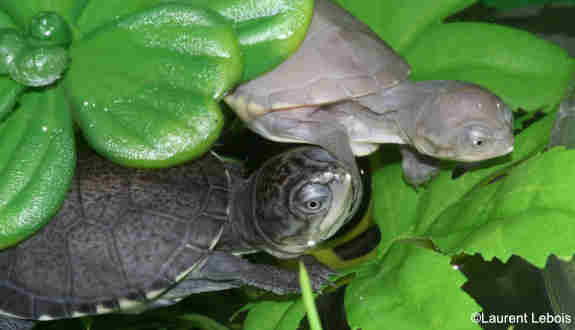
Its Paludarium
Which Paludarium for the Pelusios castaneus?
Its Paludarium
Which Paludarium for the Pelusios castaneus?
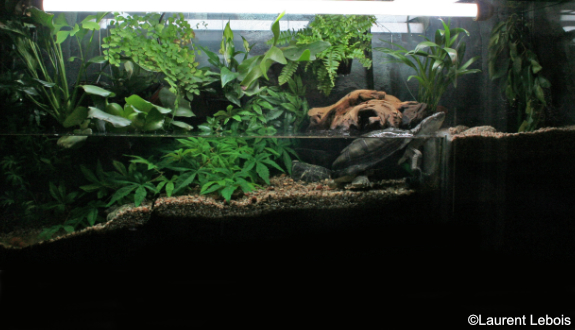
Because of its active and good swimmer side, this turtle needs a lot of room to exercise. Count a tank of at least 120 cm (47) in length for 1 specimen. But that's a minimum! The bigger the tank the better!
Arrange the aquarium with:
- - an immersion heater to heat the water to around 26-28°C or 79-82°F
- - a UVA/UVB lamp index 10.0 (allows the turtle's metabolism to correctly synthesize calcium)
- - a heating lamp to obtain a hot spot between 32 and 34°C or 89 to 93°F
- - a timer for the lamps programmed to provide 12 hours of heat and UVB (the temperature should drop a few degrees at night)
- - an emergent beach (special turtle beach, cork bark, flat stone ...) with an access ramp
- - a filter. Turtles being big polluters, the filter must follow the pace and be powerful enough. You can choose a filter specially designed for turtle tanks, an external filter or an internal filter that you can lay in the water. The recommended power ranges from 5 to 10 times the volume of the tank per hour). To break the current, you can direct the filter discharge towards a wall.
- - secoration for these shy turtles, both in the water and in the dry part (turtles sometimes have trouble getting out of the water if the beach is too clear): large stones, roots, plastic plants... Be careful that your installation is safe for the turtle: if it gets stuck under water, it can drown. The ground will be covered with fine sand such as Loire sand for example.
On the maintenance side, clean the filter once a week and change the filter media every 6 months (but never all at the same time). Change half of the water once a month with dechlorinated water (let it rest in a bucket for 48 hours).
The water should be between 1 and 1.5 times the length of the turtle. This will allow him to breathe by simply putting himself on his hind legs. If you wish a greater height it is possible provided that the turtle has points of support (rocks, roots...).
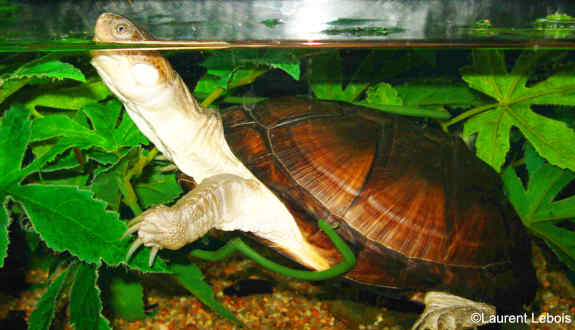
Good To know
Find all additional information!
Good To know
Find all additional information!
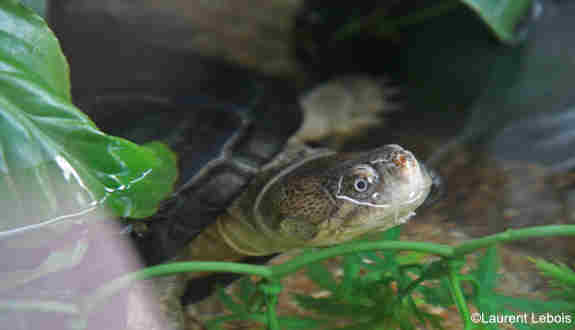
The Pelusios castaneus can be fully enclosed in its shell thanks to a mobile hinge located on the front part of the breastplate.
Even if it is shy by nature, you can gently accustom your turtle to feeding in your hand.
Like all turtles, the Pelusios does not appreciate manipulations that make it stressed. You should do it as little as possible. If you have to, take it on the back of the carapace to avoid bites.
Yours photos!
Comments
Sort by:
Please login to post comments
